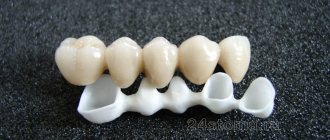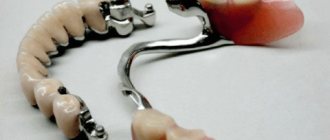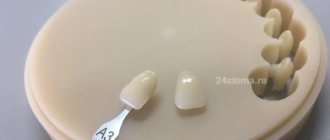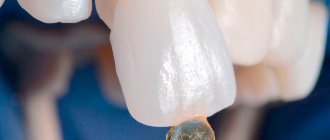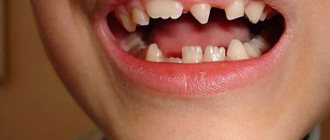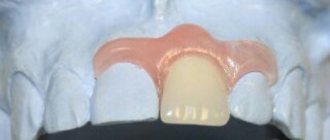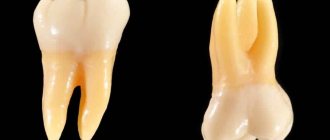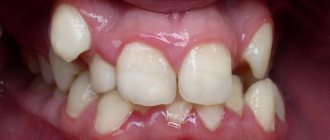Porcelain crowns are the best option for tooth replacement in terms of aesthetics
Article navigation
- Porcelain: material features
- Indications and contraindications
- Types of porcelain crowns
- Advantages and disadvantages of the material
- Porcelain crowns: the process of creation and installation
- How to fix the product
- Care rules for long-term use of dentures
- Life time
- Comparison of porcelain with other materials
- Price issue
Question for a specialist
Teeth are one of the strongest parts of our body, but, nevertheless, they are not immune from the negative effects of the food we eat, the lifestyle we lead, and the environment.
They grow twice, in the milk and permanent dentition, and if we fail to maintain their original shape, color, functionality, then we have to find ways to correct the situation. Fortunately, today prosthetic technology is experiencing its heyday, and restoring damaged or destroyed teeth is not a problem. Today, attractive porcelain crowns, for example, are in increasing demand. Let's look at the features of this material and the stages of manufacturing structures based on it in detail.
Installation conditions
All orthopedic products have certain indications for use. Taking the latter into account, the dentist selects the most suitable designs for a particular patient. Installation of porcelain crowns is indicated in the following cases:
- Allergic reactions to products made of metals or alloys. In such a situation, porcelain crowns are the optimal prosthetic option. This is due to its hypoallergenicity.
- For restoration of molars. Today, such use of crowns has become possible. This is due to changes in the technological process of manufacturing porcelain mass. Due to this, the material has an increased strength coefficient.
- For covering front teeth. The manufactured structures are characterized by being close to the natural color of the enamel. Even at close range, it is difficult to see the difference between real teeth and artificial teeth.
- High sensitivity to polymers. Due to the bioinertness of the material, it interacts well with the tissues of the oral cavity, which makes it suitable for those who have similar problems.
- In case of complete destruction of crowns or complex restoration of several adjacent teeth.
On the front teeth
In addition, installation of products is recommended for some diagnoses. Among them:
- non-carious enamel disorders.
- enamel hypoplasia;
- destruction of the cutting edge;
- wedge-shaped defects;
- light and shaped anomalies of teeth.
Porcelain: material features
Today, porcelain, first used in prosthetics just over two centuries ago, is considered the most popular material. Crowns made from it are essentially a ceramic product without metal impurities in the composition. The product is produced by processing ceramic mass at high temperatures. The complexity of the manufacturing process of porcelain structures determines their high qualities - wear resistance, precision fit, high aesthetics. They are easy to install, hypoallergenic, and serve their owner for many years, maintaining their original color and shape.
This is interesting! It is believed that the first dentures with a porcelain component appeared about three centuries ago. Orthodontist Pierre Fauchard sharpened crowns from durable ivory, additionally strengthening them with a layer of gold. To make the structure look aesthetically pleasing, he made the top covering from a thin layer of ceramic to match the adjacent units. It was only towards the end of the 19th century that the technology of firing a porcelain crown on platinum foil appeared.
It is important to understand that porcelain and ceramics are actually the same thing. Porcelain is a type of ceramic, one of its highest quality types, since it has a snow-white color even from the inside, i.e. in cross-section, as well as high strength characteristics. But in dentistry there is no division as such into “porcelain” and “ceramics”, so crowns are generally called ceramic, even though there are varieties (pressed ceramics, regular or even with the addition of a composite).
Ceramic processing methods
- firing: a crown is created from a single piece and subsequently fired in a kiln under very high temperatures,
- casting of frames followed by cladding: first, a frame is created, after which it is covered with a thin layer of porcelain. Next comes firing again. This option is more preferable because it reduces the number of pores and makes the material stronger. But technically this option is quite difficult to implement,
- pressing: used specifically for pressed ceramics. This technique was developed by Ivoclar, which produces such material under the E.max brand,
- CAD/CAM: this technology involves computer modeling and subsequent milling of the material, that is, the creation of the exact shape of the crown in accordance with the virtual model. It is mainly used for pressed ceramics, since such material is extremely difficult to process manually.
Indications and contraindications
Porcelain structures are an excellent choice in many problematic situations. Here is a list of indications for their installation:
- allergies to plastic or metal: porcelain crowns are absolutely compatible with oral tissues, they are hypoallergenic,
- ideal restoration of the smile area: porcelain has excellent light transmission and perfectly matches the natural shade of the enamel, which allows you to make the prosthesis very aesthetic and hide its presence from others (it will not stand out against the background of neighboring teeth),
- the need to restore teeth severely damaged by caries or other dental diseases,
- the need to restore teeth that have fluorosis, hypoplasia, a wedge-shaped defect: in this case, prosthetics with crowns are resorted to if it is not possible to correct the defect by other methods (for example, whitening),
- the need to adjust the shape and position of the tooth: crowns can be used only if there is slight curvature or deviation from the norm, otherwise the patient may be recommended to wear braces.
Contraindications to the installation of these orthopedic products should also be taken into account. Limitations include serious malocclusion, bruxism, and various inflammatory processes in the oral cavity in the acute stage. First, you need to eliminate the existing problems in the doctor’s chair, and only then can you begin prosthetics.
Watch a video about dental crowns
Notice
: Undefined variable: post_id in
/home/c/ch75405/public_html/wp-content/themes/UltraSmile/single-item.php
on line
45 Notice
: Undefined variable: full in
/home/c/ch75405/public_html/wp-content /themes/UltraSmile/single-item.php
on line
46
Rate this article:
prosthetics
Types of porcelain crowns
The types of porcelain dentures are determined by their location in the oral cavity - in the front (frontal smile zone) or on the side. In addition, such prostheses can be made from various types of materials.
Made from classic ceramics
Such crowns are made of classic ceramics or porcelain. They are distinguished by high aesthetics and fairly good strength. They are placed mainly on the front teeth, since this is where the appearance is most important, while the chewing load is reduced to a minimum - that is, the risk of product breakage is reduced.
Made from pressed ceramic
In fact, it is lithium silicate, which today is commonly called glass ceramics. There are no pores in it, so the aesthetics of the finished product remains at the same high level, but at the same time the strength characteristics increase significantly. This category includes IPS brand materials (e.max and Empress), which are most popular in the dental market today.
On a note! Very often, ceramic crowns include products made from zirconium dioxide (or oxide). Unlike zirconium, it is not a metal, but simply an element or material that is completely incorrect to call ceramics. In general, ceramic or porcelain or zirconium dioxide crowns constitute a group of metal-free products – this is already the correct name.
What you need to know before getting crowns
- It is recommended to install dentures if the crown part of the tooth is destroyed by 50% or more. It is irrational to put a filling, as it can break off.
- Crowns are placed only on “dead” teeth. Tooth canals must be perfectly sealed, this will minimize the risk of periodontitis (inflammation of the tissue around the root).
- If a patient has a tendency to allergic reactions, he must notify the doctor about this.
- Which crown is best to install will be decided by the orthopedic dentist together with the patient. In recent years, metal-ceramics and metal-free ceramics have become very popular.
Advantages and disadvantages of the material
It is no coincidence that Europeans call special dental porcelain an enamel substitute. Prostheses made from it not only perfectly replicate the anatomical features and shade of the original units, but they are also smooth, translucent, and have a mirror-like shine. Exactly like enamel. Porcelain teeth, if they are truly made with high quality, cannot be distinguished from natural ones. Therefore, the material is often chosen for prosthetics of the front teeth - those that are located and clearly visible in the “smile zone”.
Complex on 4 OSSTEM implants with delayed loading - 140,000 rubles.
Complex implantation Osstem (South Korea) with delayed loading after 4-6 months.
Doctor's work guarantee - up to 5 years (under an agreement on the provision of medical services) Call now or order a call
Opening hours: 24 hours a day - seven days a week
In addition, they are quite durable and resistant to chips, and perfectly retain their original shade even when exposed to coloring pigments from food. With proper installation and high-quality oral care (regular hygiene, professional cleanings, avoiding combining hot and cold foods), porcelain products will delight you with their shine, stable shade and shape for about 10-15 years.
And if you have long dreamed of a flawless smile, then porcelain crowns are a great way to achieve it. Installation is quick, the designs are well suited for allergy sufferers who may react to polymers or metal. Products made from pressed ceramics are very light, and you get used to them quickly.
However, this modern aesthetic material has its drawbacks. Due to its fragility, the material does not allow the manufacture of bridge structures. Only single restorations are made from it. And the production of porcelain dentures itself is expensive, which affects the final cost of the product. Especially if the choice fell on modern pressed ceramics.
Interesting! The very first known dentures, as archaeologists testify, were allegedly made from the teeth of wolves and other wild animals. The artifacts were found in Mexico and date back to 2500 BC. Later, dentures were made from the shells of sea creatures and were fixed in the mouth with gold rings. Until the middle of the 18th century, dentures were made from ivory and the teeth of various animals.
Methods for making porcelain dentures
Modern dentistry distinguishes between two main methods for producing porcelain teeth:
- layer-by-layer application. Ultra-thin strokes of liquid porcelain are applied onto the frame using balls. Each layer, after being spread on the base, is fired in a specialized dental furnace. In total, the average product requires approximately 8-12 layers. After obtaining the required thickness, the frame is discarded, and the finished structure is ground and polished;
- pressing. More advanced equipment is used, which makes it possible to compress a homogeneous porcelain mass to a record dense consistency. The technology for such production is known only in general terms and is not disclosed. In general, pressed dentures are considered more durable and of higher quality than layer-by-layer dentures.
Porcelain teeth are undoubtedly the optimal balance of aesthetics, strength, durability and price. It is because of this that they are gaining more and more popularity with each goth.
Porcelain crowns: the process of creation and installation
The process of creating porcelain dentures is quite labor-intensive. It consists of two stages.
Preparatory stage
At this stage, the doctor determines the condition of the tooth that will need to be restored. The specialist also sanitizes the oral cavity and performs therapeutic procedures. Next, the doctor begins to work with the tooth on which a ceramic prosthesis will be installed. It is advisable to remove the nerve from it to protect it from further inflammation under the crown.
If there is nothing left from the top of the tooth, it will not be possible to fix the crown - you must first build up the tooth. For this, pins or stump inlays are used (the first option is universal, the second is individual, laboratory). If the crown remains, then it is given the shape of a cone. Pure ceramics are quite thin, so little living tissue is ground away - a layer of hard tissue will need to be removed from the prepared unit to form a ledge 0.8 to 1.5 mm wide. It is this thickness of the walls of the future porcelain crown that ensures the strength of the product. The prepared apex becomes like a cylinder or a truncated cone.
Next, the orthopedist makes several impressions or impressions of the prosthetic area and the entire jaw. And selects the shade of the future artificial unit. The data obtained will be sent to the dental laboratory, where the prosthetic structure will be manufactured. Take this period up to a couple of weeks. During this period of time, the doctor will install a protective temporary plastic structure on the prepared tooth.
Laboratory stage
The technician, having received all the data from the orthopedist, begins making the crown. First, a model of the patient's jaw is cast based on the impressions. A cap made of platinum foil is placed on a specific tooth, which is filled with porcelain mass. Next, the product is double fired - inside and outside. The final stage is adjusting the size, giving the shape, the desired shade and glazing the resulting artificial tooth, final firing at a very high temperature - just under 1000°C.
On a note! Some ceramic materials (mostly pressed) are processed using CAD/CAM milling technology. That is, first a scan of the oral cavity or a finished model of the jaw is performed, the crown is created in a special program, and then turned on a robotic machine. Of course, this is more expensive for the patient, but it is more accurate, and the result is more predictable.
How long does the procedure take?
The duration of the procedure depends on the type of dental crown and the wishes of the patient. Usually several visits to the dentist are required. During the first visit, the doctor will conduct a consultation and refer the patient for an x-ray. After this, impressions of the teeth will be made, and then dentures. The duration of one session depends on the complexity of the work and the number of crowns; on average, the patient has to spend 1-2 hours in the dental chair.
It is important to know. The durability of crowns largely depends on the quality of the dentist’s work. Therefore, choosing a clinic must be approached very responsibly.
How to fix the product
The finished product must be tried on. The doctor evaluates how the prosthesis fits into the color range, checks the quality of the design, determines whether it interferes with the bite, whether it puts pressure on the adjacent tooth, or injures the mucous membrane. If the prosthesis needs adjustment, it is carried out. If everything is in perfect order, you can proceed to installing an artificial tooth - and here there are two options:
- fixation with temporary cement: the patient walks with a new artificial tooth for 2-3 weeks. During this period of time, it is important to determine the degree of comfort of the product, note all the sensations that arise and possible discomfort. If you fix the crown directly with permanent glue, you will no longer be able to correct the product,
- fastening with permanent cement: if the patient does not express any complaints, you can begin treating the crown with an antiseptic and fixing it to the stump. After this procedure, the structure is considered permanent; it cannot simply be pulled out of the mouth and adjusted.
Preparation before production
To ensure a harmonious combination of the crown with other organs of the dentition, the doctor takes a combined impression.
After preparing the stump, a copper ring is placed on it, which is pre-filled with a special mass. While it is in the oral cavity, an impression of the entire dentition is taken. A plaster model is cast on it.
It is necessary that the cast of the stump be inserted and removed well into it. Thanks to this, it is possible to produce a high-quality porcelain crown.
Care rules for long-term use of dentures
In order for porcelain structures to serve you for a long time, it is important to treat them with care. By taking the following precautions, you will extend their life:
- Clean your mouth thoroughly after each meal - use an irrigator, rinse,
- do not use dental floss or brushes in the area of the installed crown - it can be damaged,
- Once every six months, carry out hygienic cleaning in the dentist’s chair: caries does not threaten the artificial tooth. However, the resulting plaque can penetrate under the gingival margin and destroy the root system of a living tooth,
- give preference to foods that are not very hard or particularly tough: also avoid eating too hot or too cold food and drinks at the same time (such temperature changes can negatively affect not only the enamel of living teeth, but also any artificial material),
- Give up bad habits: don’t snack on floss with restored (as well as natural) teeth, don’t open lids, don’t bite your nails.
Advantages and disadvantages
The main positive aspects of using porcelain crowns in dental prosthetics include their complete identity with natural human teeth. Due to their hardness and excellent appearance, they are quite popular among visitors to dental offices. At the same time, analyzing the positive and negative aspects of these crowns, one cannot fail to mention a number of disadvantages:
- the inherent fragility of ceramics;
- insufficiently tight fit to the gum and tooth;
- high degree of abrasiveness, which affects the contacting teeth;
- the relative high cost of such artificial teeth compared to polymer and metal ones.
The lack of an ideal fit at the attachment points forces dentists to operate on a larger area in the patient’s oral cavity; in addition, deterioration in the strength of the attachment can correspondingly affect articulatory properties.
Life time
Only careful oral care and care for structures can significantly extend the life of both teeth and dentures. Porcelain is a highly aesthetic material, but it is fragile. Therefore, it is important not to place unnecessary pressure and stress on the restored tooth. This leads to rapid wear of the prosthesis and cracks. If you suddenly feel that the product is moving while chewing food, this is a reason to consult a doctor.
Zirconium dioxide crown on an implant for all 55,000 rubles instead of 80,000 rubles!
OSSTEM implant (South Korea), individual zirconium abutment, gum former, impression taking.
Creation of a Prettau zirconium crown using 3D modeling technology. Consultation with 2 doctors: an orthopedist and an implantologist for free! Call now or request a call
Opening hours: 24 hours a day - seven days a week
What prices should you expect?
The cost of crowns depends on the selected material and manufacturing technology. Price formation is also influenced by the level of the clinic, the qualifications of the doctor and dental technician. Today, metal-plastic structures are the cheapest, and metal-free ceramics are the most expensive.
By contacting the Saint-Dent Clinic, you can count on receiving high-quality dental treatment. Patients will be provided with a free half-hour consultation, during which the doctor will explain what is included in the cost of services. You can find out how much it costs to install crowns here. And here patients can find out the contacts of the Saint-Dent Clinic.
Comparison of porcelain with other materials
To understand whether dental porcelain is right for you for dentures or not, look at its comparison with other materials.
Differences from plastic
Prostheses made of polymers are easier to process, and their installation is easier. However, plastic crowns lack such advantages of porcelain products as high aesthetics, hardness and preservation of the original shape, shade and transparency. In addition, they are porous, so they do not retain color for a long time - they can only be considered as a temporary option for restoring dental defects.
Differences from metal ceramics
Products containing metal impurities can cause allergies and oxidize over time under the influence of saliva. The slightly more expensive and much more aesthetic dental porcelain does not have this drawback. The combination of metal-ceramic materials is suitable for prosthetics of chewing units, but in the smile area under certain lighting it will not look very aesthetically pleasing. Porcelain teeth require more care and adherence to rules than metal-ceramic teeth, but they also last longer.
REPROSTHETICS WITH ACRYLIC PROSTHETICS - RUB 200,000.
Re-prosthetics with an acrylic bridge on a metal frame (all included) up to 12 units.
Save RUR 30,000. Call now or request a call
Differences from zirconia
This material is ideal from all points of view: beautiful, hypoallergenic, strong, wear-resistant, which allows it to be used on chewing and frontal units. But it has a drawback - a high price. However, zirconium dioxide often costs the same as pressed ceramics.
How to choose a crown
What dental crowns are best ? Much will depend on the dentist’s recommendations and the patient’s financial capabilities. When choosing the material from which the structure will be made, you can follow these tips:
- Dentures made of aluminum oxide and zirconium dioxide look very beautiful and are practically indistinguishable from real teeth. They will be an ideal option for people who are not going to save on their smile.
- Metal ceramics are the ideal combination of price and quality.
- Zirconium crowns are suitable for young people. They have an attractive appearance and last for more than 20 years.
- It is better for older people to install durable and relatively inexpensive metal-ceramic structures.
Price issue
When choosing between different materials, it is important to consider their cost. The question of how much a porcelain crown costs concerns many. The price of prostheses made from this material starts from 10 thousand rubles and reaches 20-30 thousand per unit including installation. Also take into account the costs associated with preparing for prosthetics - treatment of the abutment tooth, as a rule, always has to be paid separately.
Author: Chernov A. R. (Thank you for your help in writing the article and the information provided)
Reviews
Have you ever had to install porcelain crowns? How long does a dental structure last? How carefully do you follow your doctor’s recommendations?
How much did orthopedic treatment cost you? Leave your feedback about the procedure itself and the quality of the finished products in the comments.
If you find an error, please select a piece of text and press Ctrl+Enter.
Tags crowns fixed dentures porcelain crowns
Did you like the article? stay tuned
